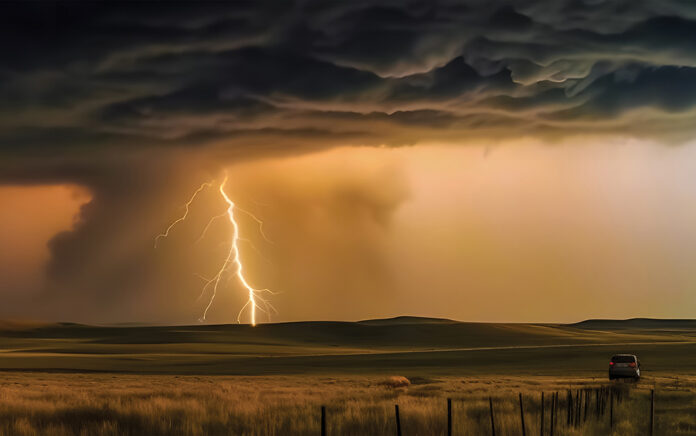You can see it in the eyes of a mother as she catches first sight of her newborn child, it happens when we gaze up into a star-spangled night or stare deep into a tropical ocean. But what actually is this ‘magical’ thing we call awe? What we certainly know is that we all sense it, and probably have done since the dawn of time, but for most of us, it’s just a feeling perhaps. Something that doesn’t need explanation, we just can’t put a finger on that’s all.
A new type of thinking is essential if mankind is to survive and move toward higher levels. – Albert Einstein
The problem with awe is that it not only applies to things we can see but also to things we don’t know much about or are told we should be concerned about.
Take, for instance, the picture above. Few of us would ever doubt the awesome power of a tornado as it trawls its way across the American mid-west, but what if we told you that the picture itself isn’t actually real? It was, in fact, created with artificial intelligence now available in the latest beta version of Photoshop.
Awe not only inspires aspirational thoughts; it can also induce fear.
Artificial intelligence
Where artificial intelligence is concerned, Australian existential thinker Toby Ord sees ‘unaligned AI’ as a serious threat to humanity. Currently, he estimates a one in ten likelihood that unaligned AI will cause human extinction or permanent and drastic curtailment of humanity’s potential unless significant steps are taken. The argument here is that, once an AI reaches a certain level (or quality) of intelligence, it will be better at designing AI itself, than humans.
Ord sees five big risks: those around nuclear war, climate change, other environmental damage, engineered pandemics and what he describes as unaligned artificial intelligence.
“While I see the final two as especially important, I think they all pose at least a one in 1,000 risk of destroying humanity’s potential this century, and so all warrant major global efforts on the grounds of their contribution to existential risk,” he ominously warns in his book, The Precipice.
A fear response
An existential risk is certainly something that can cause awe – of the fearsome kind that is.
For most of us though, this strange, if temporary phenomenon or emotion, is something that simply envelops us as we view the southern aurora or the northern lights or gaze at a great work of art, watch a ballet or marvel at an orchestra as its meticulously created sounds wash over us.
And where would human beings be without it? Somehow we all like to be inspired. Perhaps it drives our basic curiosity about what lies over the next hill. In the past it drove us to cross the oceans of the world and led us to create machines to explore the universe.
The question of what awe really is has fascinated Berkley’s Dr Dacher Keltner since he was a child.
Keltner has been studying human emotion for decades and is a co-founder and director of UC Berkeley’s Greater Good Science Center, a research institute that probes questions about our social and emotional wellbeing.
His latest book, “Awe: The New Science of Everyday Wonder and How It Can Transform Your Life,” explores the social, physical and mental benefits of this powerful emotion. He approaches the subject, in part, from an anthropological perspective, exploring how this emotion shapes our social fabric.
“As a species, we are very interdependent,” he told CNN’s Eva Rothenburg. “But the central challenge to healthy social networks, which is vital to our health, is unbridled self-interest.”
The power of awe, he argues, is that it motivates us to see beyond our own desires. It “quiets the voice of the self” and, consequently, “makes you share things and collaborate with other people.”
Central to our understanding of awe, Keltner holds, is its relevance to human health and the role it plays in healing.
Close interpersonal connections and our overall happiness and health were the subjects of the Harvard longitudinal study on interpersonal relationships. The study was started back in 1938 and followed 268 participants.
Of the original cohort, only 19 were still alive in 2017, when further evaluations were released. Those remaining were all in their mid-90s. Among the original recruits were eventual President John F. Kennedy and longtime Washington Post editor Ben Bradlee. Women weren’t included because the College was still all male.
Six years ago, Keltner co-authored a study mapping the self-reported emotions of over 850 participants as they watched more than 2,000 short videos. The researchers catalogued 27 emotions, some of which were more likely to co-occur and so were considered related.
A distinct emotion
The study found that awe was experienced as a distinct emotion, different from beauty, although it was often reported alongside “admiration” and “aesthetic appreciation.” Keltner concludes, therefore, that it’s important — albeit difficult — to differentiate stimuli that are simply beautiful from those that tend to evoke awe.
Much of Keltner’s initial work was inspired by his efforts to make sense of life after his brother’s death.
” I took a moment each day to be open to the awe-inspiring around me. I sought out places of importance in the history of awe. I engaged in open-ended conversations with people I consider awe pioneers. I immersed myself as a newcomer in various wonders of life. They brought me to the conviction that awe is almost always nearby, and is a pathway to healing and growing in the face of the losses and traumas that are part of life,” he says in his book.
Mapping emotions with Google
In association with other researchers, Keltner partnered with Google Arts and Culture in 2021 to map emotions users reported when looking at different artworks online. From 1500 works, participants reported that 60 artworks made them feel some level of awe. Other words they chose to describe these works were “mysterious,” “striking,” “cosmic,” “spiritual,” and “intimate connectedness.”
To understand and appreciate your own sense of connectedness, Keltner says it’s important to slow down and drink in your surroundings.
“Look for things that challenge your scale, both small and vast,” he said — anything from a pattern created by flowers near the sidewalk to the silhouette of your city’s skyline on your commute.
He promises you’ll thank yourself later.






